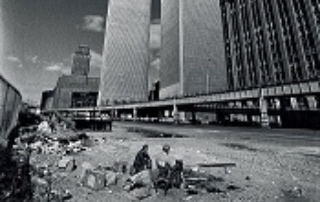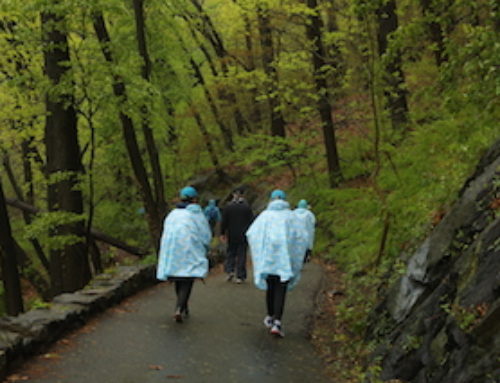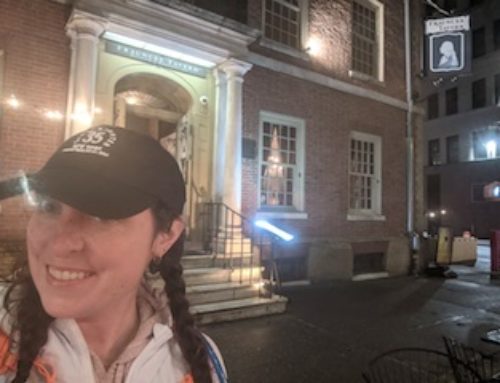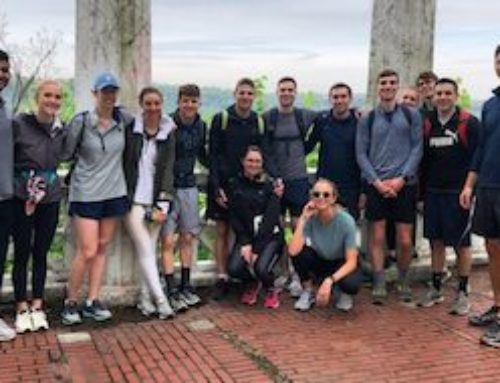
A brief history of the Shorewalkers
by Cy Adler
Since 1982, Shorewalkers has been a leading advocate of environmental and other quality-of-life projects in the New York City Metropolitan Region, emphasizing the opening to the public of waterfront property.
Shorewalkers’ first hike took place Sunday, December 12, 1982 along the west coast of Manhattan. Our announcement read:
“Explore the changing Hudson River Coast, Battery Park, the Westway Route, active piers, through Penn-Central railroad yards and into Riverside Park. Lunch stop in Harlem. Wilderness above the George Washington Bridge, wind up in an Irish pub in Inwood.”
We walked through Penn Central Yards, which were then active railroad freight lines between 59th St. and 72nd St. The rail yards have since been converted to blocks of dull condominiums and a strip of green called Riverside Park South. And it really was wilderness north of the George Washington Bridge along the deteriorating waterfront through little used parks, one of which is still unnamed. At the time, Irish Inwood bars dispensed beer at 15 cents a glass, a price that shocked several lawyers who walked with us. “Westway” was the highly debated proposed highway in a tunnel from 42nd St. to the Battery to be built on landfill. It would have added at least 300 acres of parkland to the Hudson River Park. Alas, it was never built.
A few facts about The Great Saunter Footpath in a Timeline
1985- 1989
The first hike was lead around much of Manhattan in 1982, but not always along the waterfronts. The paths were unsafe and often illegal to access.
The first few years of the hike that lead to the Great Saunter was attended by less than 30 people. The greenway was not accessible as it is today. In 1985, in lower Manhattan, the newly opened Battery Park City opened accessibility to the waterfront and hikers walked along the seedy piers (such as Christopher Street) heading uptown passing homeless bedding all the way to the West 60’s. It is up for debate when the official first Great Saunter began but has been voted to be 1985. Throughout the ‘80’s, numerous spots were blocked, and hikers walked along a dirt path along the old grimy Penn Rail Yards that is now Riverside Park South. Freight trains still ran along the rails and the route was adventurous, but not all that safe. Shorewalkers were warned not to pass through the rail yards due to the hazardous and unsafe conditions. Hikers passed through the opening of a fence, cut by the then Executive Direct of Riverside Park. Throughout the 80’s, real estate development began to boom along the Westside. By 1987, there was an estimated 100 walkers as part of the Great Saunter.
1990- 1994
1992 “On one expedition through Inwood Hill Park we had planned to walk north across the Henry Hudson Bridge… to the Bronx, but soon discovered that the Metropolitan Bridge and Tunnel Authority does not make this easy for hikers. When we came upon the tollbooth from the east and began to clamber down to it, a guard rushed over and threatened immediate arrest if we continued. … He told us the north walkway no longer existed and that we had to find a path under the bridge from which we could climb up the east side to the east walkway. After some scrambling over rocks and through brush we managed to locate the path and ambled over the bridge” – Cy Adler, Walking Manhattan’s Rim: The Great Saunter.
1995- 1999
“In 1995, the city invested over $100 million into …(Chelsea Piers), large four story structures in an effort to raise Chelsea up from its rather outdated, industrial appearance.
“In 1998 the Hudson River Park bill was passed in Albany to build a park that would extend the present five acres of parkland below Chambers Street to include over five miles of Manhattan waterfront…. Under the Hudson River Park plan, a four-and-a-half-mile waterfront esplanade and bikeway…stretch(es) from Battery Park to West 59th Street…. Up to 1999, the piers in the area were largely used as parking lots and sanitation truck and bus storage.” – Cy Adler, Walking Manhattan’s Rim: The Great Saunter, pg. 33.
2000- 2004
Riverside Park South opened to the public in 2000 giving access to the Hudson with scenic views incorporating the relics of a once thriving rail yards and a modern designed park.
In 2002, Pier A, a once brightly painted ex-fireboard that was home to a fleet of firefighting vessels pier, was converted into upscale restaurant in Battery Park. Also in 2002, Newsday reported that the Great Saunter participation was at nearly 140 walkers. Spots along the East Harlem were fenced off and walking along the shore was now diverted to public streets. The black and white mountain was from then on no longer accessible.
In 2003, Green Eagle Press publishes Cy’s Adler’s book Walking Manhattan’s Rim: The Great Saunter.
In 2004, the New York City Parks and Recreation Department releases “The Manhattan Waterfront Greenway Plan”, outlining plans to revitalize and restore Manhattan’s Greenway and riverfront accessibility.
2005- 2009
Park accessibility along is Hudson is more open than ever and now becoming home to walkers, cyclists, tourists and locals. Although the High Line is not officially part of the Great Saunter footpath, construction began in 2006, building excitement over a new outdoor space for New Yorkers and visitors.
Until 2009, there was not bike path at West 131St Street connecting the greenway beneath Riverbank State Park. Great Saunter walkers were sent toward the large staircase sending them the up the cliff to Riverside Drive and then crossing the pedestrian bridge into Riverbank State Park. Walkers returned to the greenway at the north end of the facility to exit down two more flights of stairs.
2010- 2014
The Eastside Greenway receives bids to redesign the pathways along the East River from 120th Street to 59th Street, as well as extend the greenway behind the United Nations building to connect the pathways between the Upper Eastside and Murray Hill. The greenway along the seaport is opened to the public and restoration in lower Manhattan progresses from the damaged caused by Hurricane Sandy to the area.
Milestone in 2014 as the Shorewalkers’ Great Saunter increases its participation to nearly 1,200 hikers.
2015
Revitalization in Battery Park is near completion and as new path near Dyckman is under construction to connect the greenway gap between Fort Tryon and Inwood Hill Parks.
Memories from long time Shorewalker,
by Christine Yost:
There used to be so many homeless camping out…well not really camping… people had built shelters under the elevated West Side Highway in the West 60’s. Also, some lived in the train tunnel where you could peer in around 83rd street. Not that there was a real walkway along the river past these areas, but there was some sort of unofficial path, along the Hudson River- south of the promenade area of the West 70’s and north of the area with old ship piers. Interesting piles of broken debris…old sinks, old tubs…all piles up. Today, there are no obvious shelters, no obvious homeless… no piles of broken debris. On a nice day, many cyclists and walkers compete for limited space taking advantage of the gorgeous walkway built along the Hudson River.
Back 30 years ago, homeless bedding sites lined the beautiful arched roof Gustavino structure at West 79th street exit/entrance to the West Side Highway (now home to the Boat Basin cafe). There are now cafes along the Hudson, that’s surely a change in the last 30 years.
Hawks now nest sometimes very near the Hudson River uptown. You can always tell where they might be nesting because you see photographers with telescopic lenses lining up taking their pictures. I don’t remember seeing a hawk anywhere in NYC before in past 10 – 15 years.
There used to be more boats at the West 79th Street Boat Basin. I hear that they now require boats docking there to be “seaworthy”; consequently, a number had to leave because they were used as residences and never left the dock.
Before Battery Park City was built, there was a large area of landfill. In the late 1970’s, Creative Time created the “Art on the Beach” program. You never knew what to expect when you visited. As many artists participated and installed their artwork, none of the exhibits were permanent and there was a wonder in having a sandy beach to walk on. At least for a little while. Now, this area houses thousands of people in Battery Park City, also a lovely, landscaped walkway/promenade along the Hudson River.
Some things haven’t changed…the views of Statue of Liberty, the view of the George Washington Bridge. The view of the WTC has come and gone and in its place a memorial and an exceptionally tall tower. The view across the Hudson River to New jersey has sprouted dozens of skyscrapers.
The west side piers are no longer in use as ships docked for regular cross Atlantic travel. The Intrepid Museum had just opened at the time when Shorewalkers first organized. Now the piers host large cruise ships and the Intrepid has grown, acquiring a space shuttle, a submarine, and all sorts of aircrafts.
At the west end of Dyckman Street, 30 years ago there was a broken pier and a few abandoned structures (referred to as “boat houses”, not that there were any apparent boats); today, this area features a popular restaurant and a boat basin.
Back in the 1980’s the Fulton Fish Market, aroma and all, was especially active in the wee hours. Now this colorful market is gone (relocated to the Bronx) and the area, from what I read, will gain additional housing. The South Street Seaport area when first re-developed was a wonder… that there was access to the waterfront and without danger, one could stroll to the waterfront and view the bridges at night.
The piers and area along the Hudson River in the West Village and Meat Market area were famous party grounds of a grittier time; today much seems to have calmed down, at least regarding the partying. However, the piers are amazingly rebuilt…and enjoyed by loungers, sunbathers and families.
The North River sewage treatment plant (Riverbank State Park) not only brought all sorts of amenities (from a swimming pool to a theatre, and views of the Hudson River, and a cafe) to the West 140’s but also cleaned up the Hudson River waters remarkably… apparently so much that now the worms once again thrive and rot the piers.
In the early 1980’s it was hard to find functioning restrooms. No Starbucks and very few facilities. Now the walkway along the Hudson River is on its way to being well equipped, at least on the west side of Manhattan and now attention is turned to the Eastside.
The Frying Pan, with its eclectic and charming features, docked along the Hudson in the West 20’s only arrived in the late 1980’s. It’s a popular place to visit, have a coffee and relax.
Best of all changes is the now long and almost continuous walkway along the Hudson…the first half of the Great Saunter route.”
Below is a video of the Great Saunter by Scott Sarisky showing his Great Saunter:




